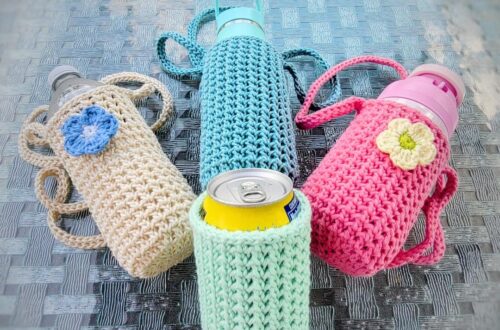Felt Crochet Coin Purse
 Heirloom projects are some of my favorite. The idea of someone in the future picking up and admiring a project I made many years before has always warmed my heart.
Heirloom projects are some of my favorite. The idea of someone in the future picking up and admiring a project I made many years before has always warmed my heart.
Coin Purses have always had that same sense of whimsy in them. I have fawned over many, beaded, felted, knit, and crochet alike. Whatever the medium, the fascination is the same, and what better way to pay homage than to make our own! The best thing about this project is how deceptively simple it is. An absolute beginner of crochet or felting could tackle it in no time!
Let’s get into it.
Supplies:
- Patchwork Scissors (Mini) – Art. No 493/CW
- Needle Felting Mat (Large) – Art. No 8911
- Pen Style Needle Felting Tool (+ Refill Needles) – Art. No 8901
- Felting Needle Tool (+ Refill Needles) – Art. No 8900
- Sashiko Needles (Long) – Art. No 2009
- Clover Amour Crochet Hook (Size H/5.00 mm) – Art. No 1047/H
- Assorted Wool Roving
- 30+ Grams of Worsted Weight Raw Wool Yarn
- Heavy Weight Thread
- 3.3” Coin Purse Clasp Lock Frame

Beginning Side Panels:
To begin, chain 12 with your raw wool yarn.
Round 1: Double crochet 1 stitch into the third chain from the hook. Double crochet 8 stitches across. Double crochet 6 stitches into the last chain. Turn your work to where the bottom of your chains is now facing up. Double crochet 8 stitches across into the bottoms of previously worked chains. Double crochet 5 stitches into the last chain. Slip stitch into the first double crochet to join. There should be 28 stitches.





Continuing Panel:
Round 2: Chain 2 and Double crochet 2 in the same stitch. Double crochet 1 in the next 8 stitches. Double crochet 2 in the next 6 stitches. Double crochet 1 in the next 8 stitches. Double crochet 2 in the next 5 stitches. Slip stitch into the first double crochet to join. There should be 40 stitches.
Round 3: Chain 2 and Double crochet 2 in the same stitch. Double crochet 1 in next 9 stitches. (Double crochet 2 in next stitch, Double crochet 1 in next stitch) 6 times. Double crochet in next 8 stitches. (Double crochet 2 in next stitch, Double crochet 1 in next stitch) 5 times. Slip stitch into the first double crochet to join. There should be 52 stitches.
Round 4: Chain 1 and Single crochet 1 in the same stitch. Single crochet 1 in every stitch around. Slip stitch into the first Double crochet to join. There should be 52 stitches.





Finishing Panel:
Break yarn and weave in beginning and end tails. You don’t have to be perfect with your end weaving, we’ll be felting it all together anyway! Make one more identical panel before moving on to felting.


Beginning Felting:
Place panel on felting mat. Take 5 prong felting needle tool and place straight up against the fabric. Try to only use the tool around the middle of the felting mat. Be sure to have tool perpendicular to the mat. If felting at an angle, you run the risk of breaking needles or accidental pokes. Press down with felting tool repeatedly. Work in sections, pressing down repeatedly for about 15 seconds each pass. You will begin to see the stitches on the front side become more defined, and the back side become fuzzy.




Continuing Felting:
Once the entire panel is felted down on one side, it should look similar to the photos below, with the top stitches being well defined, and bottom stitches being fuzzy. Flip panel over and repeat the process. Now, you will notice the fuzzy side becoming a more solid fabric. Once that side is completely felted, repeat the process of flipping over and felting to your liking. A good indicator of the felting process ending is when both sides look even and solid with minimal fuzz.





Felt Decorations:
Now is time to let your creativity take over! Grab some assorted wool roving, and the pen-style felting tool. I chose white, yellow, and green for a freehand daisy. Pull small sections off of roving and tack down onto fabric with the felting tool. Make sure you like the placement before felting down all the way. Once you are happy with the placement, felt down roving, adding more to the section as needed. Only felt down on the front side of the panel, do not felt backside, as this will cause the base fabric color to bleed into the design. Once you are happy with your design, you can begin assembly!






Attaching Clasp:
Place one panel against open clasp, with rounded edge to rounded edge. With your smallest Sashiko needle and about 12” of heavy thread, run the needle through the fabric, then the first hole of the clasp from the inside to the out. Pull through with about 3” of thread left on the backside. Pass the needle through the next hole, catching felted fabric. Continue the process of backstitching along the entire side of the clasp. Weave both ends of the thread into felted fabric. Repeat process on the second panel.




Joining Panels:
Taking about 18” of thread, sew both panels together using a blanket stitch on the outside of the work. For best results, space each stitch out evenly with about a centimeter of distance between them, and at the same depth. After stitching around the panels, weave the ends of the thread into fabric.




We’ve completed our coin purse! Now you will have a beautiful heirloom piece to be treasured for years to come. With your own personal style in felt decorations, this coin purse will be tailored perfectly to you and bring your personality across to a lasting project. Be sure to tag Clover and me in your finished purse, we’d love to see your take on it! And keep an eye out for me on the Clover blog in a couple weeks, where I’ll be showing you how to make some chic jewelry with the French Knitter tool!

Follow what Quayln is up to next on his Blog | Instagram | Facebook | Pinterest | YouTube | Ravelry
Stay connected with Clover on Facebook | Twitter | Instagram | Pinterest | YouTube | Ravelry
[mc4wp_form id=”11289″]


